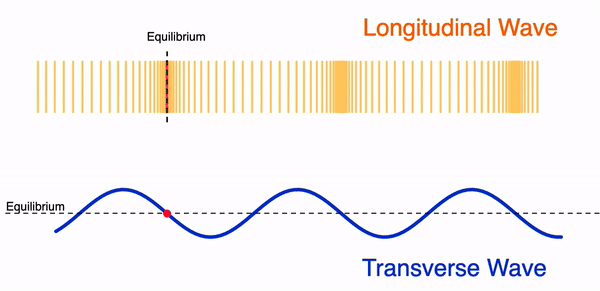The first of two apps on Phase Difference allows for interaction to demonstrate the oscillation of two different particles along the same wave with a variable phase difference.
The second shows two waves also with a phase difference.
In both cases, the phase difference $\Delta\phi$ can be calculated with
$$\Delta\phi = \dfrac{\Delta x}{\lambda} \times 2\pi$$
where $\Delta x$ is the horizontal distance between the two particles or the horizontal distance between the two adjacent identical particles (one from each wave) and $\lambda$ is the wavelength of the waves.
I modified Tom Walsh’s original GeoGebra app to add a moveable single oscillating particle for students to observe its movement along a longitudinal wave and a transverse wave.
The app can also be used to show how the displacement of a particle in a longitudinal wave can be mapped onto a sinusoidal function, similar to the shape of a transverse wave. For example. a displacement of the particle to the right can be represented by a positive displacement value on the displacement-distance graph.
You can choose to select the particle that you want to focus on by using the slider.
For a full screen view, visit https://www.geogebra.org/m/auyft2pd
Here is an animated gif for those who prefer to insert it into a powerpoint slideshow instead:

For embedding into SLS or any platform that supports iframes.
<iframe scrolling="no" title="Progressive Waves" src="https://www.geogebra.org/material/iframe/id/auyft2pd/width/640/height/480/border/888888/sfsb/true/smb/false/stb/false/stbh/false/ai/false/asb/false/sri/true/rc/false/ld/false/sdz/false/ctl/false" width="640px" height="480px" style="border:0px;"> </iframe>This GeoGebra app allows students to observe closely the movement of a particle in a progressive wave, with two possible directions of energy propagation.
In a typical question, students will be asked to predict the next movement of a particle given that a wave is moving left or right. Usually, students will need to imagine the waveform shifting slightly to the left or right in order to figure that out. This app follows the same visualisation technique to identify the subsequent movement of any particle along a wave.
I used this demonstration to start a conversation about refractive index with my IP3 kids. These hydrogels certainly generated a lot of excitement as the kids were fascinated with how invisible it becomes when placed in water.
You can get a 1000 (yes, one thousand!) of these for $1.29 at Shopee. Make sure to choose the transparent ones instead of the coloured version when checking out.
Say goodbye to the messy demonstration involving the soaking of glass in a beaker of vegetable oil or glycerin.
As promised, I am sharing another purchase made during this mid-term break for my kids.
Magdeburg hemispheres are used to demonstrate the power of atmospheric pressure. This simple demonstration kit consists of two plastic hemispheres, a rubber ring, a one-way valve, a syringe and some rubber tubing.
First, the one-way valve and the syringe are attached to the hemisphere that has a nozzle.
The two hemispheres are then placed together with the rubber ring between them. The rubber ring will serve as a seal as the hemispheres press against it when the air is pumped out.
As the syringe is pulled, the pressure inside the sphere decreases. This results in the atmospheric pressure being significantly larger than the internal pressure and thus, the hemispheres can not be pulled apart by hand.
To separate the hemispheres, remove the tubing and the hemispheres will simply fall apart as the internal pressure rises and reaches an equilibrium with atmospheric pressure.
The kit can be bought for less than S$3 here. There are other sellers that seem to offer lower prices, which I realised while doing a search for the keywords “Magdeburg Hemispheres” only after making the purchase because I was thinking it could not get any lower.